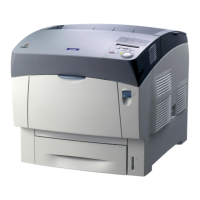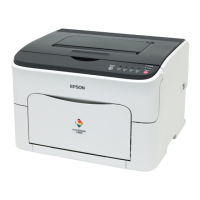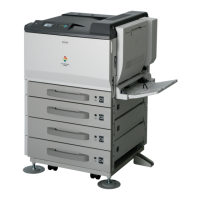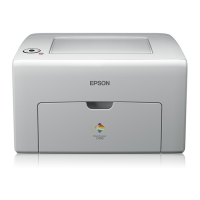AcuLaser C2800/C2800D/C3800/C3800D Revision C
TROUBLESHOOTING Procedure for Troubleshooting 79
Confidential
3.1.4 Notes on Using FIP
1. The troubleshooting method described here assumes that there is no malfunction
in the printer controller (BOARD ASSY, MAIN). If you cannot fix a problem
even by following the troubleshooting procedure, replace the printer controller
with a normal one and then follow the same procedure.
If you cannot recover the printer from the trouble even with the printer controller
replaced, replace the “Possible parts that caused the error” shown in FIP and
related parts with new ones one by one, and repeat operation checks.
2. Have spares of the MCU, LVPS, HVPS, FUSER UNIT, TRANSFER UNIT, and
any other part in advance as they may be required to identify the cause of the
trouble in FIP troubleshooting.
3. Be sure to unplug the power code before starting troubleshooting work unless
instructed to plug it in. Never touch any live parts unnecessarily with the power
cord connected.
4. Conventions used to represent connectors are as follows:
P/J12: Indicates P/J12 connectors are connected.
P12: Indicates the disconnected plug side.
(except when connecting directly on the board)
J12: Indicates the disconnected jack side.
(except when connecting directly on the board)
5. When, for example, “P/J1-2PIN <=> P/J3-4PIN” is indicated in FIP for the voltage
check, set the plus side of a measuring tool to “2PIN” on “P/J1” and set the minus
side of the tool to “4PIN” on “P/J3”.
6. When, for example, “P/J1 <=> P/J2” is indicated in FIP for the voltage check,
check for all the relating terminals between “P/J1” and “P/J2” with reference to
Chapter 7 “Connectors” (p.396).
7. Taking “P/J1-2PIN <=> P/J3-4PIN” as an example, the minus side “P/J3-4PIN” is
AG (Analog Ground), SG (Signal Ground), or RTN (Return). Therefore it is
possible to connect to another AG, SG, or RTN pin as the minus side instead of “P/
J3-4PIN”. Before doing so, check that each AG-to-AG, SG-to-SG, or RTN-to-
RTN has continuity properly. Be careful not to connect to a wrong pin since the
level of AG, SG and RTN are different from each other.
8. Use a special tool for measuring voltage of a small connector. Be careful of the
sharp edge of the tool.
9. When measuring the voltage, perform measurement with the TRANSFER UNIT
and paper cassette loaded, FRONT COVER closed, and the power turned ON.
10. All voltage values given in the FIP are approximate values. Actual measured
values should not be completely the same as those given in the FIP.
11. Note that FIP does not provide any description on removal of parts which are
supposed to be removed to remove the target part, and the procedures.
12. Any parts listed in “Possible parts that caused the error” in the FIP are regarded as
the source of the trouble and signifies that the parts or the assemblies (HIGH
ASSY) containing those parts should be replaced with normal ones one by one,
and checking should be repeated.
13. In this chapter, paper feeder at the bottom of the printer is referred to as "Tray1",
and optional paper feeder is referred to as "Tray2”.
14. FIP may contain descriptions that distinguish between certain specifications. Be
sure to follow such instructions properly to remedy the problem.

